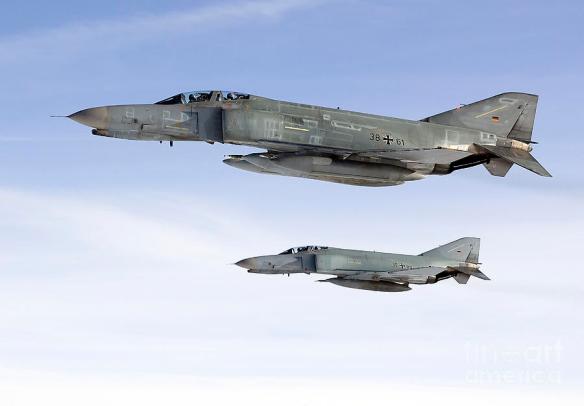In 2005 and 2008, Luftwaffe F-4F Phantom II fighter planes took part in the Baltic Air Policing operation (of NATO), and these fighters were supplemented in 2009 by units flying the Typhoon.
In 2006, to support military operations in Afghanistan, the Luftwaffe sent over several Panavia Tornado reconnaissance planes from Aufklärungsgeschwader 51 “Immelmann” (the 51st Reconnaissance Wing “Immelmann”), stationed in Mazar-i-Sharif, Northern Afghanistan. There have also been assorted German Army helicopters flying from the Luftwaffe Air Base in Mazar-i-Sharif. Also, Luftwaffe C-160 Transall have flown transport plane missions in and around Afghanistan.
Since the 1970s, the Luftwaffe of West Germany and later the reunited Germany (as well as many other European air forces) has actively pursued the construction of European internationally-made warplanes such as the Panavia Tornado and the Eurofighter Typhoon introduced into the Luftwaffe in 2006.
On 13 January 2004, the Minister of Defense, Peter Struck, announced major changes in the future of the German armed forces. A major part of this announcement was a plan to cut the number of fighter planes from 426 in early 2004, to 265 by 2015. Assuming that the plans to order 180 Typhoons is carried out in full, and all of the F-4 Phantoms are removed from service, this would cut the number of Tornado fighter-bombers down to just 85.
In the past, the Bundesmarine’s naval air wing (the Marineflieger) received 112 Tornado IDS planes. However, during late 2004, the last unit of Bundesmarine Tornadoes was disbanded. All of the maritime combat role was assigned to the Luftwaffe, and one unit of this has had its Tornadoes fighters equipped to carry Kormoran II missiles and American HARM missiles.
On 20 September 2011 Defense Minister Thomas de Maizière announced that the Air Force would shrink to 23,000 soldiers and thus have to undergo major restructuring. Air Force Command and Air Force Office will be disbanded and replaced by a newly formed Air Force Command with three subordinate commands: Air Force Operations Center, Operational Forces Command, Support Forces Command. The three Air divisions, the Air Force Training Command and Air Force Weapon Systems Command will be disbanded as well.
The combat forces will see a major reduction with the three surface-to-air missile units merged into a single wing in Husum in Northern Germany. The wing will field 14 MIM-104 Patriot and 4 MANTIS systems. The three Air Transport Wings will be merged into a single wing based at Wunstorf Air Base, which will field 40 A400M Atlas transport planes. The Luftwaffe will field three Multirole Eurofighter Wings, each with two squadrons for a total of 140 Eurofighter Typhoon. A Fighter-Bomber Wing fielding Panavia Tornado IDS and Panavia Tornado ECR planes will remain in service at Büchel Air Base. The Reconnaissance Wing 51 will remain in service and add one drone squadron to its Panavia Tornado IDS squadron. In May 2013 both Ministers of Defence announced plans for integration of Patriot Air Defence Units of the German – & Dutch Air Forces to optimise operations, training & support.
